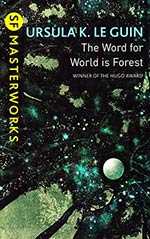
![]() Rhondak101
Rhondak101
3/3/2012
![]()
Many of the GMRC reviewers have noted that some books seem very much of their times. In fact, I commented in my review of Ray Bradbury’s The Golden Apples of the Sun that several of his stories seemed dated. In reference to Ursula K. Le Guin’s The Word for World is Forest, no observation could be more untrue. The novella upon which the novel is based won both the Nebula and Hugo Awards in 1973. The novella appeared in Harlan Ellison’s second New Wave anthology Again, Dangerous Visions in 1972. Le Guin published the novel version in 1976. However, with its focus on ethnic and ecological concerns, it seems as if it could have been written last year.
The novel takes place in New Tahiti Colony, on the planet Athshe. Terran workers have come to this tree-covered planet to harvest the trees and return them to Earth, which is mostly barren. In comparison, “New Tahiti was mostly water, warm shallow seas broken here and there by the reefs, islets, archipelagoes, and the five big Lands that lay in a 2500-kilo arc across the Northwest Quarter-sphere. And all those flecks and blobs of land were covered with trees. Ocean: forest. That was your choice on New Tahiti. Water and sunlight, or darkness and leaves” (15-16). Because this is one of Le Guin’s Hainish novels, the planet’s population was seeded by the Hains centuries earlier. The indigenous population are, of course, forest dwellers, but they took a very different evolutionary turn than their “cousins” the Terrans. The Athsheans are about a meter high with green fur. They look much like monkeys. The Athsheans have complex sleeping patterns, which involve multiple “naps” and lucid dreaming. The Terrans misinterpret the Athsheans’ biorhythms. At first they think that the Athsheans will make good slaves or members of the Voluntary Autochthonous Labor Corps (their euphemism) because they don’t sleep. Later the Terrans think that the Athsheans are lazy because they don’t realize that their “Voluntary Autochthonous Laborers” are napping rather than just sitting still and staring into space. This behavior leads the Terrans using verbal and physical violence to make their workers “productive.”
One of the best “motivators,” in his opinion, is Captain Don Davidson. He is one of the workers at the logging camp and is one of the of the three point of view characters in the novel. The second is Selver, a former Athshean slave who attacked Davison and then was allowed to escape by Captain Raj Lyubov, who is an anthropologist and the third point of view character. Davidson demonstrates the callous attitude towards nature that caused his Earth to become barren. He calls the indigenous population “creechies” and hunts the animals on the planet for sport. He sees himself as “a world-tamer”: (14). He thinks “it’s Man that wins, every time. The Old Conquistador” (15). Selver is not “a world-tamer” but “a world-changer.” He learns violence from the Terrans and teaches the Athsheans how to attack in order to save themselves and their world from the colonizing Terrans: “Selver had brought a new word into the language of his people. He had done a new deed. The word, the deed, murder” (124). Lyubov is the tragic middle man. He understands both cultures and sees each culture’s inability to interpret the other. The Terrans are too greedy and too stubborn to attempt to understand the “humanity” of the Athsheans, while the Athsheans, as the weaker colonized people, quickly decide that they must adopt the violent ways of the humans if they want to keep their world.
This book is the perfect marriage of Le Guin’s interests in anthropology and ecology as well as her penchant for standing up and speaking out. In her introduction to the book, reprinted in The Language of the Night, Le Guin tells us that she wrote the novella in “pursuit of freedom” … but “succumbed, in part, to the lure of the pulpit” (151). She further describes her protests against the Viet Nam War during 1968. This text illustrates her frustration with the war itself but also with the amount of collateral damage the fighting caused to the Vietnamese eco-system and the non-combatants. Her motives were transparent then and have remained so over the years. For example, the book appears beside a bed in Stanley Kubrick’s Full Metal Jacket as a telling anachronism. The irony is: even though the book was partially engendered by one of the most significant events in the late twentieth century and even though Le Guin’s ex post facto introduction almost apologizes for its proselytizing tone, the book still speaks to the world of the twenty first century. In many ways this is unfortunate because this means there are still Don Davidsons in the world.
I recommend the book highly. It is a quick read that will make you consider humanity in many of its lovely and gruesome forms. Le Guin gets the last word about this classic: “The work must stand or fall on whatever elements it preserved of the yearning that underlies all specific outrage and protest, whatever tentative outreaching it made, amidst anger and despair, toward justice, or wit, or grace, or liberty” (The Language of the Night 152).